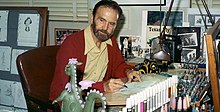
Back كين أندرسون (كاتب) Arabic كينيث اندرسون (كاتب) ARZ Ken Anderson (animator) BAN Ken Anderson (animator) CEB Ken Anderson (Autor) German کن اندرسون (پویانما) Persian Ken Anderson (animateur) French Ken Anderson (direttore artistico) Italian ケン・アンダーソン (美術監督) Japanese Ken Anderson (animatör) Swedish
Ken Anderson | |
|---|---|
 Anderson in 1977 | |
| Born | March 17, 1909 Seattle, Washington, U.S. |
| Died | December 13, 1993 (aged 84) |
| Alma mater | University of Washington (BArch) |
| Occupations |
|
| Years active | 1933–1992 |
| Spouse |
Polly (m. 1934) |
| Children | 3 |
Kenneth B. "Ken" Anderson (March 17, 1909 – December 13, 1993) was an American animator, art director, layout artist, and storyboard artist at Walt Disney Animation Studios for 44 years. He had been named by Walt Disney as his "jack of all trades".[1]
Born in Seattle, Washington, Anderson studied architecture at the University of Washington. He later studied at the École des Beaux-Arts and the American Academy in Rome. When he returned to the United States, Anderson worked for six weeks at Metro-Goldwyn-Mayer before joining Walt Disney Productions in 1934. He worked as an inbetweener and was promoted to an animator. His first major assignment was the Silly Symphonies short Three Orphan Kittens (1935). He later moved to the layout department. For Snow White and the Seven Dwarfs (1937), Anderson designed layouts, experimented with the multiplane camera, and built a model of the dwarfs' cottage.[2]
Anderson served again as an art director on Pinocchio (1940) and Fantasia (1940) for The Pastoral Symphony segment. Anderson worked closely with Mary Blair in adapting her visual style for The Three Caballeros (1944) and Song of the South (1946). He also worked on the story development for Melody Time (1948), So Dear to My Heart (1948), and Cinderella (1950).[2]
During the 1950s, Anderson joined WED Enterprises, in which he designed several Fantasyland "dark rides" for the Disneyland theme park. He subsequently worked as a production designer on Sleeping Beauty (1959) and introduced the Xerography technique for One Hundred and One Dalmatians (1961). He later contributed background and character designs for The Jungle Book (1967), The Aristocats (1970), Robin Hood (1973), The Rescuers (1977), and Pete's Dragon (1977).[3] He retired in 1978, but he rejoined WED Enterprises a year later to help renovate Fantasyland. On December 13, 1993, Anderson died from a stroke.
- ^ Canemaker 1996, p. 169.
- ^ a b Anderson 2017, p. 1.
- ^ Anderson 2017, p. 2.
© MMXXIII Rich X Search. We shall prevail. All rights reserved. Rich X Search